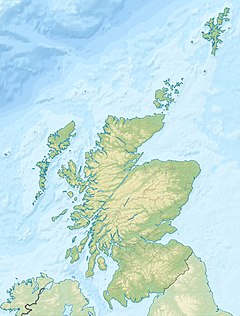Caerlanrig
Caerlanrig
| |
|---|---|
Location within Scotland | |
| Community council | |
| Country | Scotland |
| Sovereign state | United Kingdom |
| Police | Scotland |
| Fire | Scottish |
| Ambulance | Scottish |
| Website | aberdeencity.gov.uk |
Caerlanrig - also spelled 'Carlenrig' - (Gaelic: Cathair Lannraig) is a hamlet in the parish of Cavers, Borders, Scotland, lying on the River Teviot, 6 miles (10 km) north east of that river's source, and 10 miles (16 km) south west of Hawick.
Etymology
[edit]The first element of the name is probably the extinct Cumbric cair 'fortification', though Gaelic cathair has been suggested.[1] The second element is generally taken as Cumbric lanerx, meaning 'clearing' (cf. Welsh llanerch).[2] Another suggestion is that the name is Cumbric cair + Old English lang 'long' and hrycg 'ridge'.[3]
Border reiver
[edit]It is best known for being the site where John Armstrong of Gilnockie, notorious member of Clan Armstrong and brother of Thomas, Laird of Mangerton was captured and hanged by King James V for being a reiver.[4] The king's household book records that James V was at Caerlanrig on Tuesday 5 July 1530.[5]
See also
[edit]References
[edit]- ^ "Precedents of Bruce Draconarius of Mistholme: Names - Unique to Names - Yiddish". Archived from the original on 11 January 2007. Retrieved 13 February 2006.
- ^ Coates, Richard, Invisible Britons: the view from toponomastics. In George Broderick and Paul Cavill, eds, Language contact in the place-names of Britain and Ireland. Nottingham: English Place-Name Society, 41-53, "Archived copy" (PDF). Archived from the original (PDF) on 9 November 2006. Retrieved 9 November 2006.
{{cite web}}: CS1 maint: archived copy as title (link) - ^ Bethany Fox, 'The P-Celtic Place-Names of North-East England and South-East Scotland', The Heroic Age, 10 (2007), http://www.heroicage.org/issues/10/fox.html (appendix at http://www.heroicage.org/issues/10/fox-appendix.html).
- ^ Aeneas Mackay, Historie and cronicles of Scotland, vol. 1 (Edinburgh, 1899), pp. 334-5
- ^ Excerpta e libris domicilii Jacobi Quinti regis Scotorum (Bannatyne Club: Edinburgh, 1836), Appendix p. 31.
External links
[edit]- RCAHMS record for Caerlanrig
- RCAHMS record for Caerlanrig, Watch Knowe
- Gazetteer for Scotland: Caerlanrig
- Photographs of 'A tour of the Armstrong Borderland', including Gilnockie's gravemarker
- 19th-century Ordnance Survey map of Caerlanrig
- Other map sources: grid reference NT399048


